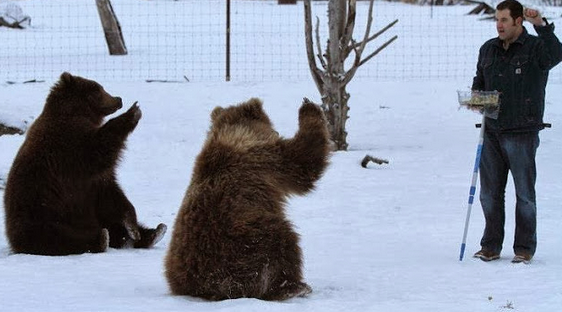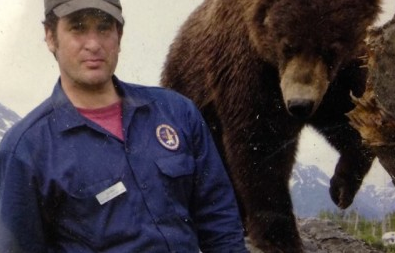

I received an interesting request from a British documentary filmmaker this week and it speaks to this fascination with anthrozoology---the study of the human-animal bond and some misunderstanding surrounding this emerging discipline. The question posed was whether or not I have raised wildlife, particularly orphaned brown bears in human care. Specifically, the producer wanted to know if I did so in a human dwelling and if I was still doing so as they have intentions of putting a film together on “trusting relations” between people and wildlife.
Evidently, there may be a false notion perpetuated out there that the human-animal bond is all about intimate connections in unnatural environments or at least human dwellings. I think this filmmaker will set the record straight. I can’t speak for other biologists and animal trainers, but why in my wildest dreams would I ever try to raise a bear that can grow to weigh upwards of a thousand pounds inside a house?
The assertion that doing so must be demonstrative of trust seems almost absurd to me. Any bear researcher, seasoned outdoors person or wildlife enthusiast could tell you that a bear has a very keen sense of smell and would probably gladly enter his care taker’s home or that of a neighbors because they can smell human food inside. Not all habituated bears are food-conditioned bears, but it would be fair to say that almost all food-conditioned bears are habituated. Bears born or raised in captivity have lost their fear of people or never develop fear of humans unless special measures are taken to reduce human contact or access to caregivers.
A bear in a zoo, for example, is a prime example of a habituated and food-conditioned bear. We don’t think of captive bears in this context, but if we did, we might be able to prevent incidents one hears about where people climb into wild animal enclosures with trained, but not tame and potentially injurious wildlife and bears, specifically. But those incidents are few and far between. These examples might, however, be useful models for teaching people about negative human-bear interactions or what we call “human-bear conflict” and the unfortunate consequences that ensue by allowing a bear to become accustomed and conditioned to humans, human dwellings and human food.
I wrote about habituated bears like 399 and her cubs for Huffington post several months ago. The Jackson Hole grizzly sow is a great testament to how a habituated bear with a reduced fear of humans is not necessarily a nuisance animal and that even these largest of land carnivores can live and thrive in proximity to people given sound wildlife management practices in human dominated areas. It is when a habituated bear is offered or gains access to human food that it becomes food-conditioned and ultimately very dangerous. When you think of Pavlovian or classical conditioning, a biologically relevant stimulus like food is intentionally or inadvertently paired with a neutral stimulus like a refrigerator or a garbage container and suddenly that neutral stimulus becomes biologically relevant.
To a black bear, brown bear (aka grizzly bear) or a polar bear, which do not typically consider humans to be a food source, we are for all intents and purposes, neutral stimuli. As soon as we present ourselves as a “vending machine” or “concession stand”, things change through both classical and operant conditioning. And if you are a grizzly and have the choice between exerting yourself to chase down a subadult moose over challenging terrain on a hot summer day or a human, who dropped a tasty bag of Dorritos (like the last human you saw), you’d start scaring people too. Dorritos taste phenomenal to a bear. You see, humans are naturally an easy source of tasty food and by accident or by intention, create opportunities for easy meals. It becomes addicting to a bear.
Unfortunately, the responsible camper down the road has no idea that there is now a food conditioned bear in the area. That bear now associates all humans with food. Hopefully, the camper has his bear spray on him to discharge, as needed, because the bear will expect him to drop a bag of Dorritos any moment. If he doesn’t he might try to get him to do so and that is when a bear becomes potentially injurious, but they are not innately so.
The moral of the story is that luring a bear into a house has nothing to do with trust, assuming it is already habituated. It has more to do with food conditioning. So I told the filmmaker that if she wants to study trust between humans and bears, a far better example would be to film my friend, colleague and distinguished bear biologist Dr. Lynn Rogers who has studied black bears and climbed into their dens with them in them for many years. That is trust!
Dr. Schaul wears many hats, and one is as a consultant to Western Wildlife Outreach (WWO), one of the nations only field-oriented outreach and education outfitters dedicated to mitigating conflict between wild carnivores and humans. WWO works largely in the western states with bears, cougars, and mesocarnivores and smaller miscellaneous terrestrial carnivore species.


